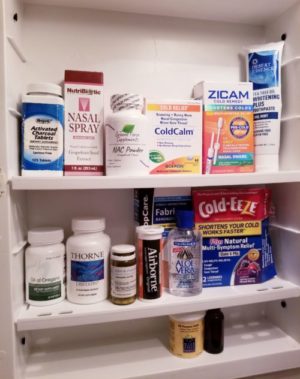WHAT TO DO WHEN YOUR CHILD HAS A FEVER
BUT WHY?
The body normally runs around 98.6°F, but mild elevations can occur normally after exercise, excessive clothing, a hot bath or hot weather. And an infant’s temperature tends to rise after bottle or breastfeeding for a half hour or more.
Most childhood fevers, in the range of 99°-104°F or 37.8°-40°C, are not harmful, and are usually due to a viral infection.
FEVERS ARE A SYMPTOM, NOT A DISEASE.
A fever is the body’s normal response to an infection by raising the temperature to a level making the body inhospitable to viral or bacterial growth. It is important NOT to prevent the body from this important infection fighting process.
The naturopathic perspective tends to regard fevers below 102°F or 39°C as “friendly” and of use to the body to help the it kill off bacteria or viruses.
A fever won’t cause any symptoms until it reaches 101.5°-103°F or 38.9-39.4°C and no harm can come to a child until it their temperature reaches 106.7°-107.6°F or 41.7 to 42.2°C.
Only 4% of children with high fevers (over 104°F) will develop febrile convulsions, which are generally considered harmless.
Children over 2 months of age can be given acetaminophen/Tylenol every 4-6 hours, but only if the child is uncomfortable and the fever is over 102°F or 39°C.
This will reduce the fever 1-2°F or by 0.5°-1 °C within 2 hours, but only if the fever was low-grade to begin with.
Dosage is determined by weight. Follow the instructions provided by the manufacturer (there are some great resources online if you’re unsure).
Do NOT give children (up to the age of 21) aspirin if they have chickenpox, sore throat, cold, or flu symptoms because it is linked to Reye’s syndrome (a rare but serious condition that causes swelling in the liver and brain).
TO TAKE YOUR CHILD’S TEMPERATURE
Rectal: Lubricate the bulb of the rectal thermometer. Hold the baby on your lap or have the child lay on the bed. It is best to keep the baby in a position that allows for minimal movement. Insert the bulb one inch into the rectum. Hold in place for 3-5 minutes. Normal is 99.6°F or 37.8°C, give or take 0.5°F.
Oral: Some children can manage an oral thermometer by age 4-5. If in doubt, use an axial or rectal temperature. Place the bulb of the thermometer under the tongue and hold for 2-3 minutes. Be sure to tell the child not to bite the thermometer. Normal is 98.6°F or 37°C, give or take 0.5°F.
Axillary: Place the bulb under the child’s arm and hold the arm down for a minimum of 5 minutes. Normal is 97.6°F or 36.5°C, give or take 0.5°F.
CALL YOUR PHYSICIAN…
Immediately if:
•
Child under 2 months •
Purple spots present on skin
•
Fever over 104°F or 40.1°C(oral) •
Difficult breathing
•
Child cries inconsolably •
Child drools or can’t swallow
•
Child cries if touched/moved •
Convulsions occur
•
Child’s neck is stiff •
Child is very lethargic
•
Child difficult to wake •
Parent is very concerned
Discuss with your physician (during next available office hours) if:
Fever lasts longer than 72 hours
Child has a history of febrile seizures
Fever left for more than 24 hours and has now returned.
Within 24 hours if:
Fever lasts longer than 24 hours
Fever between 102-104°F
Burning pain when child urinates
Child is less than 24 months old (unless fever occurs within 48 hours of DPT shot)
TO KEEP YOUR CHILD COMFORTABLE:
Encourage, but don’t force fluids. Pedialyte or diluted juice can help keep them hydrated.
Increase frequency of breast or bottle feeding.
Keep clothing to a minimum.
Provide fresh air (60-65°F).
Cold wet compresses to forehead, nape of the neck, abdomen, back or feet.
Wet sheet wrap: Use a wet sheet (wrung out so that it is not dripping wet). Wrap infant so that all skin is covered, except the face and mouth are exposed. Cover in a wool blanket. The baby may fuss at first, but will settle down. Keep wrapped for up of 30-40 minutes.
Sponge with cool or tepid water in small circles moving towards the heart; or give your child a tepid bath.
Keep child calm and resting as much as possible; no vigorous playing.
Provide simple, bland nourishing foods such as soups, broths, or rice made with tons of garlic.
 The Natural Medicine Chest (Stuff to Always Have on Hand)
The Natural Medicine Chest (Stuff to Always Have on Hand)


